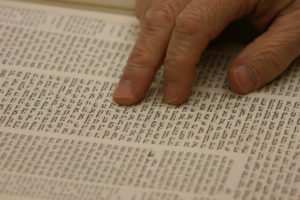Italians, Helped by an App, Translate the Talmud

Consisting of 5,422 pages of Hebrew and Aramaic, the Babylonian Talmud originally completed 1,500 years ago has defied widespread translation.
ROME — Spanning six centuries of religious and legal teachings touching on astronomy, medicine, ethics, philosophy and more, the Babylonian Talmud is so complex, it has rarely been translated.
But on Tuesday, after five years of labor by dozens of scholars, linguists, philologists and editors — as well as a crew of computer scientists and researchers — a state-funded “Project Talmud” presented the first volume of the first-ever Italian translation.
“There is now a group of scholars of the Talmud that speak the Italian language,” said Riccardo Di Segni, the chief rabbi of Rome and chairman of the translation committee, at a presentation here on Tuesday. “These pages are now part of Italian history.”
The presentation ceremony was hosted by the Accademia Nazionale dei Lincei, a renowned science academy, just across the Tiber River from the Campo de’ Fiori, where an untold number of Jewish texts — including the Talmud — were burned in September 1553 on the order of Pope Julius III.
“The Talmud has resisted the countless bonfires on which it has been thrown,” said Renzo Gattegna, president of Italy’s Union of Jewish Communities. The country has a Jewish population of about 30,000.
Consisting of 5,422 pages of Hebrew and Aramaic, the Babylonian Talmud originally completed 1,500 years ago has defied widespread translation. Until now, the best-known versions have been in English, German and modern Hebrew.
The Italian translation was made possible five years ago when the national government allocated five million euros to the project, at the urging of Rabbi Di Segni and Prof. Clelia Piperno, who became the director of the operation.
“What’s really incredible is that the project is headed by a woman,” joked Professor Piperno, an energetic law professor who managed to raise the funds, involve the Ministry of Education and the Italian Jewish community, and assemble the team of experts that tackled the translation.
“We were 12 at first, now we’re more than 80,” she said of her team.
Dozens of translators have been able to work simultaneously using a collaborative web application designed by the Institute for Computational Linguistics of the National Research Council. It is called “Traduco,” which means “I translate” in Italian.
The translation program was designed specifically to support the translation of ancient texts like the Talmud, adopting a multidisciplinary approach combining software engineering and computational linguistics.
“I am not a Talmudic expert, but after four years I came to understand the complexity of these cryptic texts,” said Emiliano Giovannetti, coordinator of the institute’s research unit. The texts, he said, could not be translated literally, as a modern work might be, but instead required an interpretive translation with explicative integrations.
Existing translation programs just were not up to the task, so new software had to be designed.
The Traduco system also allows for many people — translators, revisers and editors — to work on the text at once, allowing the translation to move at a quick pace.
The first completed volume — the Rosh Hashana Tractate — will be published by La Giuntina, and a web version will also be available in the future.
Four more volumes are ready for publication and the entire text, which consists of 36 tractates in all, should take 10 more years to finish, Ms. Piperno said.
“For a very small Jewish community to take on a job like this is a gesture of extraordinary daring,” said Rabbi Adin Steinsaltz, whose monumental translation of the Talmud into modern Hebrew began in 1965 and took 45 years to complete.
Rabbi Steinsaltz, who is also a member of the project’s honorary committee, said the public financial assistance for the project “gave honor to the Italian nation, that had the sense to support this enterprise.”